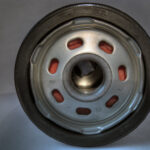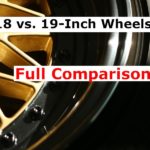Is it Safe to Drive with Low Tire Pressure? The Facts
No less than 200 people die every year in the US alone due to tire-related car crashes. Also, a survey was done by the National Highway Traffic Safety Administration (NHTSA) which said that 33% of all vehicles driven in the US have at least 1 underinflated tire.
So, the question that arises is it safe to drive with low tire pressure. In this article, we will find a detailed answer to this question and other queries related to low tire pressure in general.
Is it Safe to Drive with Low Tire Pressure?
Combine the statistics of 11,000 accidents due to car-related crashes and NHTSA’s report that 1 in every 3 cars have at least 1 underinflated tire. You would know that it is extremely dangerous to drive with low tire pressure. Underinflation can cause blown-out tires, which are the leading cause of car crashes in the world.
Tire-related issues like underinflation, overinflation, worn-out tread, misalignment, and unbalance are among the core reasons for car-related accidents. Among these the most critical problem is underinflation. Because underinflated tires can have serious repercussions. They can compromise your safety and riding comfort.
Underinflation puts your car at the risk of tire blowdown due to excessive heat. This heat comes from the unnecessary rubbing of the low air pressure tire with the road. The friction comes into play and rubber bonds are compromised. This might lead to a blown tire.
Also read: Wider Car Tires: ALL Pros and Cons
What is Considered a Low Tire Pressure?
Most light vehicles have a recommended tire pressure between 30 and 33 psi. However, this value of normal tire pressure can vary from vehicle to vehicle. Generally, any value that is more than 10% below the normal pressure rating is considered low tire pressure.
Environmental and circumstantial factors can have a great deal of impact on tire pressure. The temperature of ambient air is the main element affecting tire pressure. This is why in summers it is recommended to keep tire pressure low. As the outside heat is sufficient to increase the tire pressure to the normal value.

Other factors that can affect the tire pressure of your car are the make and model of your vehicle. For every model, look for nominal tire pressure in the handbook. If you can’t find it there, look for it on the inside of your car’s pillar. But this value can also change due to the load in your vehicle.
Therefore, in most conditions, you have to make an assessment based on the above knowledge and your personal experience. Only then you can decide that what is considered low tire pressure for your vehicle.
Why do You Have a Low Tire Pressure? And How To Fix These Problems?
Following tire problems can cause low tire pressure in your car:
- Temperature Changes
- Damaged Rim
- Punctured Tire
- Potholes and Tire Damage
- Faulty Nozzle
- Wheel Bead Corrosion
Temperature Changes:
From basic thermodynamics, we can calculate that every 10 degrees Fahrenheit drop in temperature can decrease the pressure by 1 psi. Hence, to avoid low tire pressure in winters, you must overinflate your tire according to the lowest average temperature. So that even in extreme weather, your tires are free from the risk of being blown out.
Solution: While refilling air in the tires, slightly overinflate on winter days to avoid low tire pressure. Air refilling will cost you $1-2.
Trending Video: How to Easily Bring Back to Life any Old Car Battery and Save Tons of Money (click to watch)
Damaged Rim:
A damaged or distorted rim can compromise the airtight connection between the tire and itself. As a result, the air can leak and your tire will be left with low pressure.
Solution: Rim mechanics can repair them, but it is better if you can replace them. As it can compromise the alignment and balance of your car. The cost of new rims is about $400.
Punctured Tire:
This is a pretty obvious reason for the low tire pressure. A nail or piece of glass in your tire can slowly release the air trapped inside. This will lead to the decrement of tire pressure.
Solution: Just get your puncture fixed and try to avoid traveling with low tire pressure. It will cost you $25-40.
Potholes and Tire Damage:
There are certain types of tire damage that can cause underinflated tires. One such issue is pinholes or potholes. These tiny holes cannot be detected by the puncture mechanic. But they will decrease your tire pressure very slowly over time.
Solution: Visit a car tire mechanic. They usually have binders and fillers to remove potholes. But in case the holes are beyond repair, you might have to change tires. The repair can cost you up to $100, but a tire change will cost around $250.
Faulty Nozzle:
The nozzle is a small device by means of which air is filled in the tire. It has a complete valve system that allows incoming of air and prohibits outgoing. If this system is faulty, then air in the tire will slowly escape.
Solution: A faulty nozzle needs to be replaced. It will cost you $20-40 for replacement.
Wheel Bead Corrosion:
The smooth connection between tire and rim is ensured by a circular wheel bead. This bead often catches rust and pores are created on its surface. You wouldn’t even know, and air would discharge from the tire. This will leave your tire with low air pressure.
Solution: Anti-corrosion sprays are available in the market, you can try those. But sometimes the damage has exceeded beyond repair, so you have to replace the wheel bead. It will cost you between $80-120.
Also read: Are Cheap Tires Worth it? Are They Safe?
What Bad Can Happen if Your Drive with Low Tire Pressure?
On one hand, low tire pressure can cause fatal accidents, then on the other side, it will negatively impact the fuel economy of your car as well. Your tires will wear out sooner than expected and puncture will be increased considerably.
- Fatal Accidents
The worst thing that can happen if you drive on low tire pressure is that your tires will blow out. This will cause the car to crash, and your life will be endangered.
- Fast Tire Wear
Low tire pressure increases the area of contact between road and tread surface. This means that more tire will rub with the road, hence it will wear out sooner than expected. It can lead to complete tire failure as well.
- Higher Puncture Frequency
More tire contacting the road surface means that chances of picking a nail, screw, or piece of glass are higher. Moreover, low air pressure makes tire softer and anything can penetrate in to it easily. So, the frequency of puncture is increased if you keep driving on low tire pressure.
- Reduced Fuel Economy
Low tire pressure increases the amount of friction between tires and the road. More power is drawn from the engine to overcome these frictional forces. As a result, more fuel is consumed and mileage per gallon is reduced.
Also read: 10 Cars Under $20K that Look Like They’re for $50K+
How Long Can You Drive with Low Tire Pressure?
It depends upon the condition of your tire. You can travel somewhere between 50 and 150 miles with low tire pressure. If you have a completely flat tire, then should not drive any longer than 50 miles. Otherwise, your tires will be permanently damaged.
But with issues like leakage of air due to faulty nozzle and potholes, you can travel up to 200 miles or even more. It depends upon the severity of the issue.
The 10% rule has been described above, but universally 20 psi is considered the lower limit for tire pressure. You should not drive your car at all if pressure is below the 20 psi mark.
How Does Your Car Behave with Low Tire Pressure?
Your car can behave strangely if you are driving with low tire pressure. You might experience the following symptoms:
- Even on flat roads, your car will wobble and find it difficult to travel in a straight line.
- You will feel excessive vibration while traveling at higher speeds.
- The braking traction of your vehicle is reduced, and it will take a longer distance before coming to stop after you apply brakes.
- The rider’s comfort is compromised due to shaky suspension.
- You might feel unnecessary jerks.
- Poor handling is experienced as a result of low tire pressure.
- The road grip and cornering stability of your vehicle get negatively affected.
How to Drive Safely with Low Tire Pressure?
You must avoid driving with low tire pressure at all costs. But in case if you have no way around it, then follow the instructions below to ensure safety.
- Travel short distances with underinflated tires. Go no more than 10-15 miles in each trip. On the highway, you can go up to 50 miles.
- Try to avoid driving in a harsh climate. Too much heat or too much cold can weaken your tires further and compromise safety.
- Never exceed the speed limit when your tires have low air pressure. Higher speed puts extra fatigue on them. It can increase the chances of failure as well.
- Don’t carry the excessive load in case of an underinflated tire. It increases the likelihood of a blown-out tire.
Is it Legal to Drive with Low Tire Pressure?
Though it is strictly discouraged to drive with low tire pressure, it isn’t illegal. No country in the world has so far brought legislature to this effect. Hence, you can drive your car with low tire pressure without being punished or fined for it.
Tires are the only part of your car that comes in contact with the road surface. This makes them an extremely critical part. So, illegal or not, you must not drive with low tire pressure. Only this way, you can ensure the safety of your life and the lives of your loved ones.
References:
carfromjapan.com, caranddriver.com, blog.protectmycar.com, itstillruns.com, autoblog.com, vehq.com, topdriver.com, integrity1auto.com, nsford.com, oards.com, chapelhilltire.com






